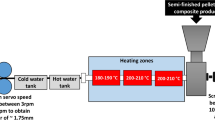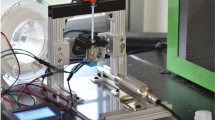Abstract
The extended rmin technique has been incorporated in the incremental updated Lagrangian formulation (ULF) of an elasto-plastic finite element computer code in order to handle the contact boundary condition when analyzing the axisymmetric tube inversion process with a quarter fillet die radius. A fillet die applies an axial compressional load onto a thin tube so that the inside or outside of the tube inverts totally making the central axis of the original tube the same as a new double-walled tube. This is called an inside-out or outside-in inversion process. This study employs an elasto-plastic finite element method to simulate and analyze inside-out inversion. The objective is to examine how different process factors, such as the geometry and material modulus, influence metal tube inversion. This study also simulates a quarter fillet radius of the die to analyze the tube forming condition and range that can be applied in engineering under these requirements. In addition, the axial compressional load under inside-out inversion stability to be suitable for a personal computer, so it can be effectively analyzed and evaluated on line instantaneously.
Similar content being viewed by others
References
Kitazawa K, Kobayashi M, Yamashita S (1988) Experiment on maximum bending radius of tube end curling. J JSTP 29(333):1043–1048
Miscow FPC, Al-Qureshi HA (1997) Mechanics of static and dynamic inversion process. Int J Mech Sci 39(2):147–161
Guist LR, Marble DP (1966) Prediction of the inversion load of a circular tube. NASA, Tech Note D-3622
Johnson W (1972) Inversion tubes, impact strength of materials. Edward Arnold, London, pp 190–193
Al-Hassani STS, Johnson W, Lowe WT (1972) Characteristics of inversion tube under axial loads. J Mech Eng Sci 14:370–381
Al-Quresh HA, De Morais GA (1976) Analytical investigation of thin-walled tube expansion by the inversion process. Design Engineering Conference and Show, ASME Publication, 9 December 1976
Schmoeckel D, Skiadas A, Mazilu P (1989) Analytical description and FE-simulation of the tube inverse pressing. Ann CIRP 38:275–278
Kinkead AN (1983) Analysis for inversion load and energy absorption of a circular tube. J Strain Anal 18(3):177–188
Kitazawa K, Seino J (1993) Shapes and sizes of inverted tubes. J JSTP 34(390):817–822
McMeeking RM, Rice JR (1975) Finite element formulations for problems of large elastic-plastic deformation. Int J Solids Struct 11:601–606
Hinton E, Owen DRJ (1974) Finite element software for plates and shells. Pineridge, Swansea, UK
Hughes TJR (1980) Generalization of selective integration procedures to anisotropic and nonlinear media. Int Num Method Eng 15:1413–1418
Oden JT, Pries EB (1983) Nonlocal and nonlinear friction law and variational principles for contact problems in elasticity. J Appl Mech 50:67–76
Yamada Y, Yoshimura N, Sakuria T (1968) Plastic stress-strain matrix and its application for the solution of elastic-plastic problems by the finite element method. Int J Mech Sci 10:343–354
Author information
Authors and Affiliations
Corresponding author
Rights and permissions
About this article
Cite this article
Huang, YM. Finite element analysis of tube inversion process with radiused dies. Int J Adv Manuf Technol 26, 991–998 (2005). https://doi.org/10.1007/s00170-003-2019-x
Received:
Accepted:
Published:
Issue Date:
DOI: https://doi.org/10.1007/s00170-003-2019-x




